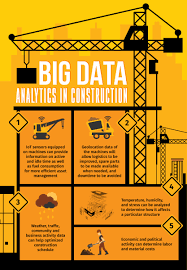How can big data analytics add value to BIM
BIM can reduce the project construction time and also the total cost

With the advent of wearables, smartphones, tablets, drones and the Internet of Things, construction workers and even the machinery are constantly collecting data at the job site. These real-time job site data will become even more powerful and enabling when integrated with external data such as weather, traffic, and business/community activities. Such influx of data (including data from previous projects) is providing an opportunity for construction businesses to optimize productivity and processes from the planning and design phase, during the construction, and if maintained properly, can be further leveraged for the operation and asset management phase as well. So, how can big data analytics add value to BIM?
Real-time data and BIM- how does this integration help?
A case study by JE Dunn and Autodesk has shown that data-driven BIM can reduce construction project cost by estimated 18%, and cut the projected completion time by up to 12 weeks. This was achieved by drastically shortening the pre-construction phase. By integrating real-time, data-driven predictive modeling system into BIM, the customer can visualize any proposed changes on the fly along with the cost estimate. Compared to the conventional 2D method, data-driven BIM has sped up the design process and even contribute to minimizing waste from the early stage.
IoT sensors in machines will provide information on active and idle time as well as fuel consumption. Such input can be processed to make machines more efficient keeping in mind costs and ecological impacts. Geolocation data of the machines will allow logistics to be improved, spare parts to be made available when needed, and downtime to be avoided. Weather, traffic, community and business activity data can help optimized construction schedule. Temperature, humidity, and stress can be analyzed to determine how it affects a particular structure. Economic and political activity which can affect labor and material costs, too, can be useful.
This isn’t rocket science, but to the less-digitized construction industry, it may well be!
Unstructured data is the biggest setback to any big data analytics application. Construction industry produces a large amount of data on daily basis – spatial data from drones and LiDAR, and non-spatial data from project documents, plans and specifications, RFIs, change orders and meeting notes. These data need to be structured with a proper infrastructure to store, curate and validate them. Then only intelligence can be created. Other than this, interoperability between software solutions and analytics tools and data capturing devices could be another hurdle.
Major industry players, including Skanska, Turner, AECOM, and Jacobs, are already building up their big data portfolio. Turning big data into viewable insights through BIM offers an efficiency that reduces project delivery time and risk of errors; resulting in increased profit margins. For an industry where 35% of costs are accounted for by material waste and remedial work, after BIM, big data analytics will be the next ultimate game-changer.
Source: https://www.geospatialworld.net/blogs/how-can-big-data-analytics-add-value-to-bim/












